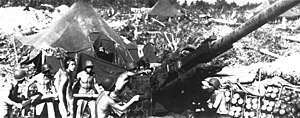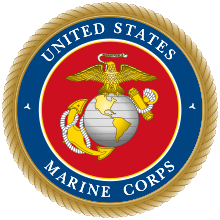2nd 90mm Antiaircraft Artillery Gun Battalion
The 2nd 90mm Antiaircraft Artillery Gun Battalion was a United States Marine Corps antiaircraft unit that was active during the 1940s & 1950s. Originally formed during World War II as the 9th Defense Battalion, it took part in combat operations on Guadalcanal, Rendova, Munda Point, and Guam. The unit, like all other US Marine defense battalions, was renamed in September 1944, becoming the 9th Antiaircraft Artillery Battalion. Returning to the United States in 1946 the battalion was again redesignated, this time as the 1st Antiaircraft Artillery Battalion. The battalion received its final designation as the 2nd 90mm Antiaircraft Artillery Battalion on 21 August 1950. It was deactivated on 15 September 1956 at Marine Corps Base 29 Palms, California.[1]
| 2nd 90mm Antiaircraft Artillery Gun Battalion | |
|---|---|
| Active |
|
| Country | |
| Branch | |
| Type | Air Defense/Coastal Defense |
| Role | Defense battalion, Antiaircraft |
| Size | ~1,300 men (1942) |
| Part of | Inactive |
| Nickname(s) | Fighting Ninth |
| Engagements | World War II *Guantanamo Bay, Cuba *Guadalcanal campaign *New Georgia campaign *Battle of Guam (1944) |
| Commanders | |
| Current commander | N/A |
History
World War II

The 9th Defense Battalion as activated at Marine Barracks, Parris Island, South Carolina on 1 February 1942.[2] Originally a training detachment, it consisted of 75 enlisted men sent over from the 5th Artillery Group located at Parris Island.[3] The 13 February 1942 the battalion departed from Naval Station Norfolk, Virginia onboard the USS William P. Biddle (APA-8) arriving at Guantanamo Bay, Cuba on 19 February.[3] The battalion consisted of 3 batteries 90mm AA artillery; 2 batteries 155 mm “Long Tom” seacoast artillery; 3 batteries each 40mm, 20mm and 50 caliber weapons designed as both anti-tank and anti-air artillery. Together with fire control apparatus, transport, and support units the battalion comprised about 1,300 men.
-From Condition Red:Marine Defense Battalions in World War II by Major Charles D., the Marine Corps' official history of the defense battalions.[4]
Guadalcanal
After Guantanamo Bay the battalion was sent through the Panama Canal to Noumea, New Caledonia where equipment was trans-loaded onto the attack transport USS Hunter Liggett that took the battalion to Guadalcanal in November 1942.[5] The battalion setup its weapons at Koli Point, and promptly shot down a dozen enemy planes.[6]
Rendova
In June 1943 the battalion left Guadalcanal and took part in the Landings on Rendova, set up its artillery and fought off attempts by the Japanese to regain control. The battalion's 155 mm “long Tom” artillery shelled Japanese positions across the Blanche Channel on New Georgia and elements were progressively moved onto the island of New Georgia to support the Drive on Munda Point and later defend the Munda Airfield and assist in the operations to seize the surrounding islands (e.g. during the Battle of Arundel Island).

After securing New Georgia the battalion was moved to Mbanika in the Russell Islands for a period of rest and relaxation prior to its next assignment that involved the recapture of Guam in the Marianas Islands.
Guam
The battalion landed near Agana, Guam on 21 July 1944.[7] They were tasked with air defense and coastal and perimeter defense of the area from Agat south to Bangi Point.[8] On Guam most of the Japanese defenders retreated to the cliffs at the northern end of the island where thousands committed suicide by jumping to their deaths. The Battalion suffered from very high rates of dengue fever during the Guam campaign and while this was not fatal it did incapacitate many Marines.
Like all other defense battalions, the unit was re-designated as the 9th Antiaircraft Artillery Battalion on 1 September 1944.[2] The unit remained on Guam for the duration of the war and returned to Marine Corps Base Camp Lejeune, North Carolina in February 1946.[9]
Late 1940s through 1956
The battalion was redesignated on 12 May 1946 as the 1st Antiaircraft Artillery Battalion. On 30 November 1949 the battalion was again redesignated, this time to the 1st 90mm Antiaircraft Artillery Gun Battalion. The last redeisgnation came less than a year later on 21 August 1950 when it was titled the 2nd 90mm Antiaircraft Artillery Gun Battalion. The unit was transferred to Marine Corps Base 29 Palms, CA in October 1953. The battalion was deactivated on 15 September 1956.[1]
Unit awards
A unit citation or commendation is an award bestowed upon an organization for the action cited. Members of the unit who participated in said actions are allowed to wear on their uniforms the awarded unit citation. The 2nd 90mm Antiaircraft Artillery Gun Battalion has been presented with the following awards:[10]
| Streamer | Award | Year(s) | Additional Info |
|---|---|---|---|
| Navy Unit Commendation Streamer with two Bronze Stars | 1942-43, 1943, 1944 | Guadalcanal, Rendova-New Georgia, Guam | |
| American Defense Service Streamer with one Bronze Star | 1942 | Cuba | |
| Asiatic-Pacific Campaign Streamer with three Bronze Stars | Guadalcanal, Southern Solomons, Rendova-New Georgia, Guam | ||
| World War II Victory Streamer | 1941–1945 | Pacific War | |
| National Defense Service Streamer with three Bronze Stars | 1950–1954 | Korean War | |
Gallery
 Landing on Rendova Island
Landing on Rendova Island 90mm antiaircraft guns on Rendova
90mm antiaircraft guns on Rendova 155mm "Long Tom" artillery being towed on Rendova
155mm "Long Tom" artillery being towed on Rendova Light tanks supporting infantry action near Bibilo Hill. Munda, New Georgia, August 1943.
Light tanks supporting infantry action near Bibilo Hill. Munda, New Georgia, August 1943.
See also
- Marine Defense Battalions
- List of United States Marine Corps aviation support units
Citations
- Melson 1989, pp. 94.
- Rottman 2002, pp. 212.
- Melson 1989, pp. 11.
- Melson 1996, pp. 27.
- Melson 1996, pp. 31.
- Melson 1996, pp. 11.
- Melson 1989, pp. 62-64.
- Melson 1989, pp. 65.
- Melson 1996, pp. 30.
- Melson 1989, pp. 93.
References
- Melson, Charles D. (1989). The Ninth Marine Defense and AAA Battalions. Turner Publishing COmpany. ISBN 0-938021-85-0.
- Melson, Charles D. (1996). Condition Red: Marine Defense Battalions in World War II (PDF). Marines in World War II Commemorative Series. Washington, D.C.: Marine Corps Historical Center. LCCN 96174419. OCLC 34920984. Retrieved 2020-05-17.
- Rottman, Gordon L. (2002). U.S. Marine Corps World War II Order of Battle: Ground and Air Units in the Pacific War, 1939–1945. Greenwood Press. ISBN 0-313-31906-5.
